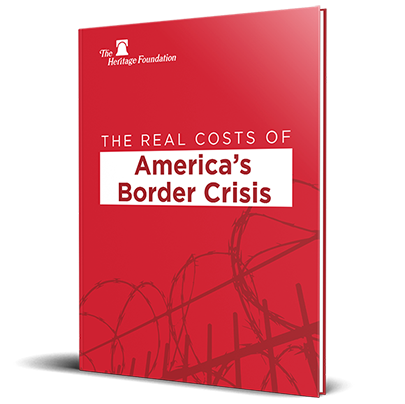Under President Biden, foreign aid has become a vehicle to promote overseas the social agenda favored by his party.REF Recently, the Republican-controlled House of Representatives issued its draft foreign aid bill,REF which seeks to restore the bipartisan and public consensus on foreign assistance while making billions of dollars in spending cuts from wasteful and counterproductive climate programs and United Nations agencies that attack Israel and support America’s enemies. The bill also restores the long-standing pro-life and pro-family provisions and support for international religious freedom that the Biden Administration had unilaterally deemphasized.
In the short term, this bill would better reflect the bipartisan public support that has characterized America’s foreign assistance programs for decades. In the medium and longer term, however, the performative rather than substantive policies of the Biden Administration threaten to politicize the entire sector.
In a recent study, we used data from the Federal Elections Commission (FEC) to examine the political orientation of the institutions of foreign assistance, and the results were profoundly disturbing.
Despite the political diversity of America’s citizens, and the decades-long battle against unjust discrimination in hiring, our review shows substantial homogeneity in the political preferences of employees of the foreign aid industry. The mono-political nature of the U.S. assistance infrastructure undermines America’s moral status as a beacon of democracy and equal rights, hinders congressional authority to set policies on foreign aid spending, suggests systematic hiring discrimination based on ideology, further undermines public trust in the ability of the federal government to accurately reflect the norms and values of the American people, and harms America’s standing in poor countries that are far more conservative in their cultural and religious beliefs.
Background
We looked at political contribution data from employees of the U.S. Department of State; the U.S. Agency for International Development; and top implementers of U.S. assistance in the humanitarian, development, and democracy sectors. In brief, we found that well over 90 percent (and sometimes 100 percent) of employee contributions went only to Democratic candidates and causes.
Elections suggest that support for the two major parties in the United States is relatively evenly split between Democrats and Republicans, so this finding suggests either systemic and institutionalized discrimination in employment or well-founded fear among employees that making their political preferences known in publicly available records could result in ostracism and retaliation in the workplace. It also adds uncertainty as to whether the foreign aid apparatus can be trusted to abide by the spending policies Congress sets forth or faithfully enact the policies of any future non-Democrat President.
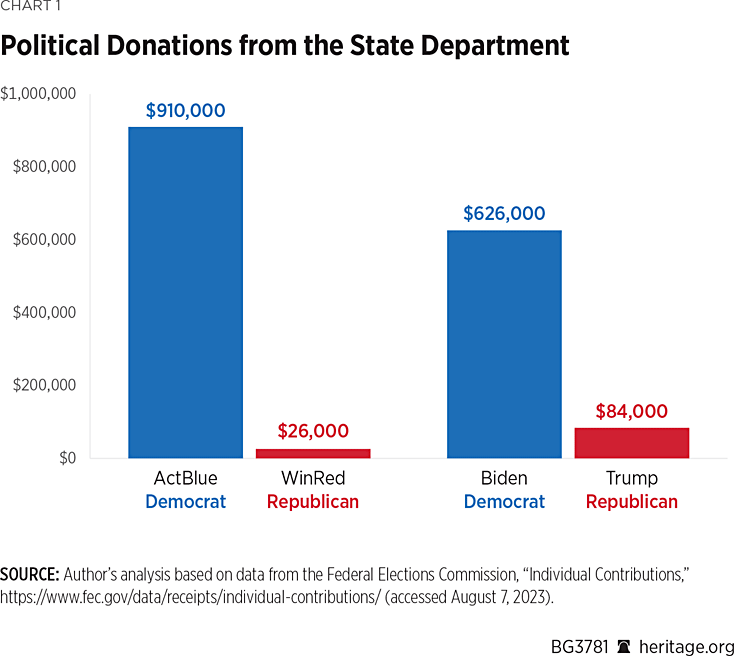
U.S. State Department
To get a better sense of the political bias among the rank and file, we focused our analysis primarily on regular staff rather than political appointees, as the latter changes according to Administration. As such, we excluded individual contributions over $2,800, which primarily came from politically appointed ambassadors. These contributions included one of over a half million dollars, one over a quarter million, and several over $100,000. In total, they were $5,678,250, dwarfing the total of all other contributions ($2,509,281). Although this would be unusual in any other agency, it is explained by the fact that large donors to both parties are often rewarded with ambassadorships. As a further screen for political appointees, we removed $2,800-plus donations from ambassadors, Assistant Secretaries, and Deputy Assistant Secretaries ($86,800).
We were left with 46,000 separate donations from 4,174 unique individuals totaling $2,411,283. Of those donations, about 44,000 of them went to Democratic candidates and political action committees (PACs), and about 2,000 went to Republican candidates and PACs. Total dollars donated were about $175,000 (7 percent) to Republican candidates or PACs and about $2,236,000 (93 percent) to Democratic candidates or PACs. On the Democrat side, $910,000 (about 41 percent of Democrat donations) went to ActBlue, a Democratic PAC, and $626,000 (28 percent) went to the Biden campaign, with the rest distributed among many different candidates and PACs. On the Republican side, $26,000 (15 percent) went to WinRed, a Republican PAC, and $84,000 (48 percent) went to the Trump campaign.
U.S. Agency for International Development
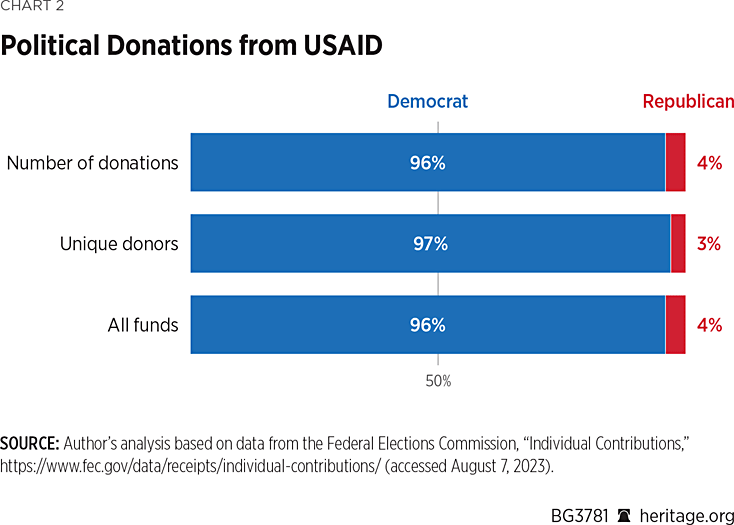
According to data from the FEC, employees of USAID made 13,100 individual contributions for federal elections during the 2019–2020 period. Of those, 12,548 (96 percent) went to support Democratic Party candidates, and 552 (4 percent) went to support Republican Party candidates. On the Democrat side, about 10,298 (82 percent) of donations went to ActBlue—984 (8 percent) to support Joe Biden, with the rest distributed among many different candidates and PACs. On the Republican side, 377 (76 percent) went to WinRed, 73 (15 percent) went to Donald Trump, the National Republican Senate Committee received 23 (4.6 percent), and the Republican National Committee received 13 (2 percent). The total number of unique donors during the period was 1,051, with 1,001 of them supporting Democrats and 50 supporting Republicans. Subtracting the 18 Republican political appointees on the list, we have 1,001 (97 percent) Democrat donors and 32 (3 percent) Republican donors. In total, USAID employees who were not political appointees contributed $655,000, of which $631,000 (96 percent) went to support Democrats and $24,000 (4 percent) went to support Republicans.
PEPFAR
Republican President George W. Bush launched the President’s Emergency Plan for AIDS Relief (PEPFAR) in 2003 as Africa faced the dire prospect of millions dying from the HIV/AIDS pandemic. It is America’s most costly foreign assistance program in history and has saved millions of lives. Average annual funding for PEPFAR has been over $5 billion, and total funding through 2022 has reached $110 billion.REF PEPFAR alone makes up the majority of U.S. global health funding, ranging from 56 percent to 62 percent over the past five years.REF
PEPFAR channels most of its assistance through large U.S. consulting firms and nongovernment organizations (NGOs). The top 10 PEPFAR partners in 2022 received 40 percent of all total funding. The top four partners are Chemonics at $710 million, FHI 360 at $207 million, the International Center for AIDS Care and Treatment Program (ICAP) at Columbia University at $153 million, and the Elizabeth Glaser Pediatric AIDS Foundation (EGPAF) at $134 million.REF Although PEPFAR was created by a Republican President and enjoys strong bipartisan support in Congress, our political donation analysis indicates that it is an entirely Democrat-run program.
Chemonics is a for-profit consulting firm that is almost entirely funded by the federal government. During 2019–2020, 375 of its employees donated an average of $400 each to federal campaigns and PACs, totaling $149,941. Of that, $145,316 (97 percent) went to Democrats and $4,625 (3 percent) to Republicans. The Republican support came from just six of 375 employees, one of whom was an executive vice president who donated $1,000 to Republicans and $1,000 to Democrats.
In 2022, FHI 360, ICAP, and EGPAF were the largest nonprofit recipients of PEPFAR funds and received a combined $494 million. During 2019–2020, 302 employees from these three nonprofits donated an average of about $500 each to federal campaigns and PACs totaling $148,906. Of that, $148,644 (99.8 percent) went to Democrats and $262 (0.2 percent) to Republicans. Just two of the 302 employees donated to Republicans.
USAID’s Top 10 Grantees
Foreign assistance is channeled through many agencies and departments across the U.S. government, with primary responsibility for foreign aid falling on the U.S. Agency for International Development (USAID). In fiscal year (FY) 2022, USAID obligated $21.9 billion of foreign aid. Although USAID gives most of its funding (56 percent) to international organizations, especially United Nations agencies, it also provided almost $10 billion to U.S.-based organizations. We looked at the political contributions made in 2019 and 2020 by USAID’s top 10 U.S.-based USAID grantees.
- FHI 360. In 2022, FHI 360 was USAID’s top American grantee, receiving $578.9 million. During the period 2019–2020, 258 FHI 360 employees made 3,577 separate contributions totaling $121,019.31, with $120,507.31 (99.6 percent) of that going to Democrats and $512 (0.4 percent) going to Republicans.
- Catholic Relief Services (CRS). In 2022, CRS received $442.2 million from USAID. During the period 2019–2020, 127 CRS employees made 1,493 separate contributions totaling $60,077.29, with $56,543.29 (94 percent) of that going to Democrats and $3,534 (6 percent) going to Republicans. Just three of the 127 employees contributed to Republican causes, and of those, one person contributed $500 to Senator Lindsay Graham (the ranking Member on the U.S. Senate Appropriations subcommittee charged with determining the foreign aid budget) and $10,865 to Democrats; one person contributed $2,800 to the nominally Republican but anti-Trump Lincoln Project and $4,290 to Democrats; and the last contributed $234 to WinRed. Subtracting the Republican contributions cancelled out by matching Democrat contributions and subtracting that $3,300 from the Democrats’ total as well leaves 99.6 percent Democrat and 0.4 percent Republican, with just one net Republican donor out of 127 employees.
- Save the Children USA. In 2022, Save the Children received $260.2 million from USAID. During the period 2019–2020, 334 employees made 3,948 separate contributions totaling $138,293.69, with $134,940.69 (96 percent) going to Democrats and $3,353 (4 percent) going to Republicans. Just six people contributed to Republicans, with one of those donating $2,757 (more than 80 percent of Republican donations) to the Lincoln Project while also donating $615 to Democrats.
- Mercy Corps. In 2022, Mercy Corps received $259.2 million from USAID. During the period 2019–2020, 179 employees made 1,987 separate contributions totaling $59,020.36, with $58,930.36 (99.8 percent) of that going to Democrats and $90 (0.2 percent) going to Republicans. Just two out of 179 employees donated to Republicans.
- JHPIEGO. Originally called the Johns Hopkins Program for International Education in Gynecology and Obstetrics and still a part of Johns Hopkins University, the organization now goes only by its acronym, presumably to differentiate itself from the other USAID programs conducted by the university. In 2022, JHPIEGO received $167.9 million from USAID. During the period 2019–2020, 54 employees made 974 separate contributions totaling $27,709.73, with $27,684.73 (99.9 percent) of that going to Democrats and $25 (0.1 percent) going to Republicans.
- Research Triangle Institute (RHI) International. In 2022, RTI International received $153 million from USAID. During the period 2019–2020, 690 employees made 8,335 separate contributions totaling $308,690.11, with $299,841.96 (97 percent) of that going to Democrats and $8,848.15 (3 percent) going to Republicans. There were 666 unique donors to Democrats and 24 to Republicans.
- Johns Hopkins University. In 2022, Johns Hopkins University received $146.6 million from USAID. During the period 2019–2020, 3,347 employees made 36,315 separate contributions totaling $1,818,103.42, with 1,769,374.44 (97 percent) of that going to Democrats and $48,728.98 (3 percent) going to Republicans. There were 3,239 unique donors to Democrats and 108 to Republicans.
- PACT. In 2022, PACT received $145.9 million from USAID. Because there are so many organizations named “Pact” in the FEC data, analysis was limited to reports from the District of Columbia, Maryland, and Virginia. This likely misses some remote workers, but it is still a representative sample. During the period 2019–2020, 36 employees made 282 separate contributions totaling $6,997.89, with all of those (100 percent) going to Democrats.
- World Vision USA. In 2022, World Vision received $142.7 million from USAID. During the period 2019–2020, 176 employees made 3,071 separate contributions totaling $86,734.89, with $79,245.64 (91 percent) of that going to Democrats and $7,489.25 (9 percent) going to Republicans. Although no systematic effort was made to identify anomalies in donation patterns, occasionally these were detected. For example, one woman at World Vision (who now works for USAID) made 984 donations totaling $30,071 during the period, while the other 175 employees made an average 12 donations each totaling $324.
- Care USA. In 2022, Care USA received $139.7 million from USAID. During the period 2019–2020, 70 employees made 584 separate contributions totaling $33,342, all of them to Democrats.
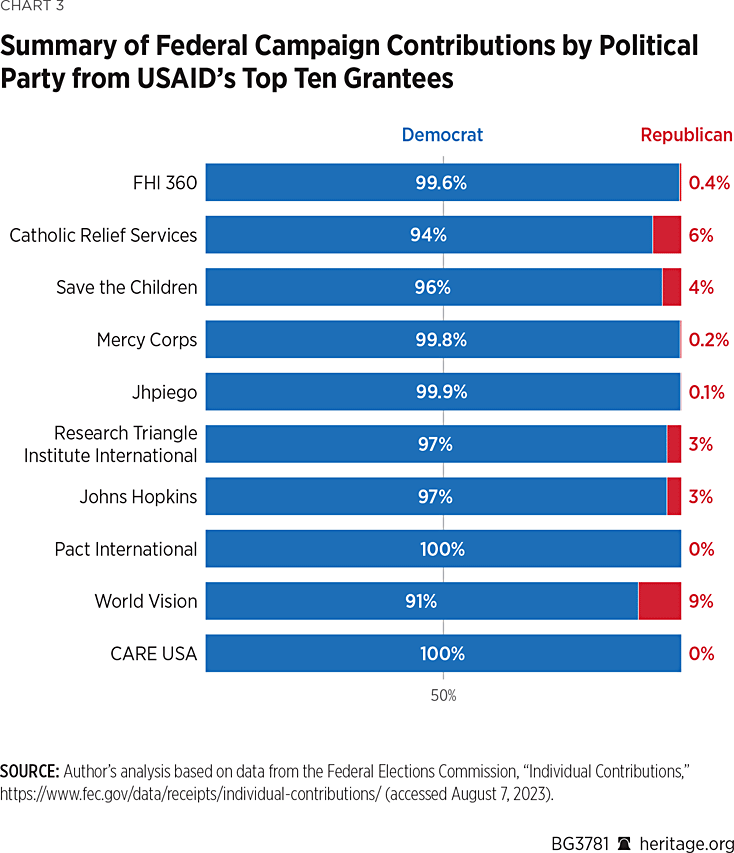
Democracy-Promoting Institutions
In a healthy democracy, every citizen should have equal opportunity for employment irrespective of his or her personal political views, but when a particular demographic (racial, religious, political, etc.) is significantly under-represented, systematic discrimination is a possibility. In the United States, political affiliation is approximately evenly split between the Republican and Democratic parties, so one would expect that in most publicly funded private organizations the political orientation of employees should reflect the general population. To test this hypothesis, we looked at the political makeup of democracy-promoting institutions using contributions recorded by the FEC during 2019 and 2020 as a proxy.
The principal democracy-promoting institutions funded by the U.S. government are the National Endowment for Democracy and its subsidiaries: the National Democratic Institute (affiliated with the Democratic Party), the International Republican Institute (IRI, affiliated with the Republican Party), the Solidarity Center (affiliated with the AFL-CIO), and the Center for International Private Enterprise (CIPE, affiliated with the U.S. Chambers of Commerce). Another important institution, focused on election administration, is the International Foundation for Election Systems (IFES). A related institution focused on conflict is the United States Institute of Peace (USIP). All these institutions receive most of their funding from Congress either directly or as pass-throughs via the State Department, USAID, or other federal agencies:
National Endowment for Democracy. During the period, 58 employees made 795 individual contributions totaling $25,564. Of that total, $480—from a single individual—went to Republicans, while the other $25,084 (98 percent) went to Democrats.
- National Democratic Institute. As expected, all 851 individual donations (100 percent) from 92 separate donors ($63,676) went to Democrats.
- IRI. During the period 2019–2020, 53 employees contributed $13,639, of which $9,711 (71 percent) went to Republican candidates and PACs and $3,928 (29 percent) went to Democratic candidates and PACs. Interestingly, although most of IRI’s support went to Republicans, political contributions came from just seven individuals, while 46 employees donated to Democrats, suggesting the (higher paid) leadership is predominantly Republican while the rank and file is Democrat. Republican donations broke down as 19 percent to the Trump campaign and 38 percent to WinRed, with most of the remaining 43 percent going to candidates and PACs representing the John McCain/George Bush wing of the party. (John McCain was chairman of IRI up until his death in 2018.)
- Solidarity Center. Although the Republican Party is increasingly the party of the working class,REF the AFL-CIO remains a Democratic Party stronghold, and 100 percent of donations from the Solidarity Center went to Democratic candidates and PACs. In total, 50 individuals made 652 donations totaling $19,961.
- CIPE. Although business used to be thought of as aligned with the Republican Party, all 151 donations (100 percent) made by employees of CIPE went to Democratic candidates and PACs, with 21 individuals donating a total of $4,116.
- IFES. Many view IFES as the premier center for international best practices in election administration. Just one of the 282 donations from employees of IFES went to a Republican organization ($25 to WinRed), although one ActBlue donor also contributed $500 to the Lincoln Project. In total, 38 individual donors contributed $6,297 (92 percent) to Democratic candidates and PACs. If we count the Lincoln Project as Democratic support, contributions to Democrats exceed 99 percent.
- USIP. Founded by Congress, USIP is intended to be bipartisan, but its political contributions suggest otherwise. In total, there were 39 unique donors, with 98 percent giving to Democratic campaigns and causes and 3 percent giving to Republican candidates and causes. (One donor gave to both Democrats [$5,400] and Republicans [$500 to Senator Lindsey Graham]). The total donated was $60,031, with $56,431 (94 percent) going to Democrats and $3,600 (6 percent) going to Republicans.
All of these publicly funded institutions were founded during the Administration of Republican President Ronald Reagan, but today they have been captured by supporters of the Democratic Party and are devoid of any political diversity. This is quite an irony for entities that the American people rely upon to promote democratic values and institutions abroad but at home practice political discrimination.
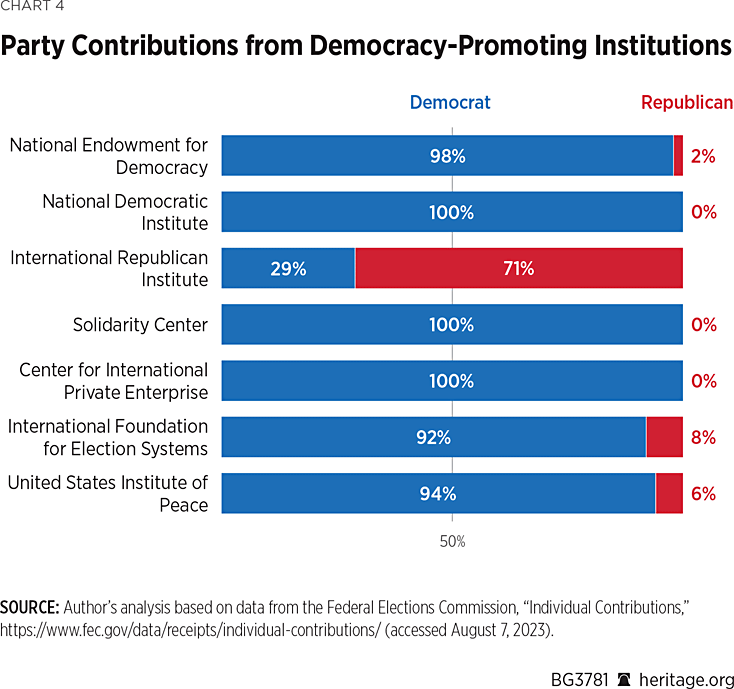
As part of our review of USAID’s political bias, we looked at the distribution of political contributions of its proposed grantees and partners as described in its unpublished May 1, 2023, budget narrative for the Center for Democracy Rights and Governance (which the author directed during the Trump Administration). Unsurprisingly, our results show similar, if not extreme, political bias in the employment composition of these taxpayer-funded organizations. (See Table 1.)
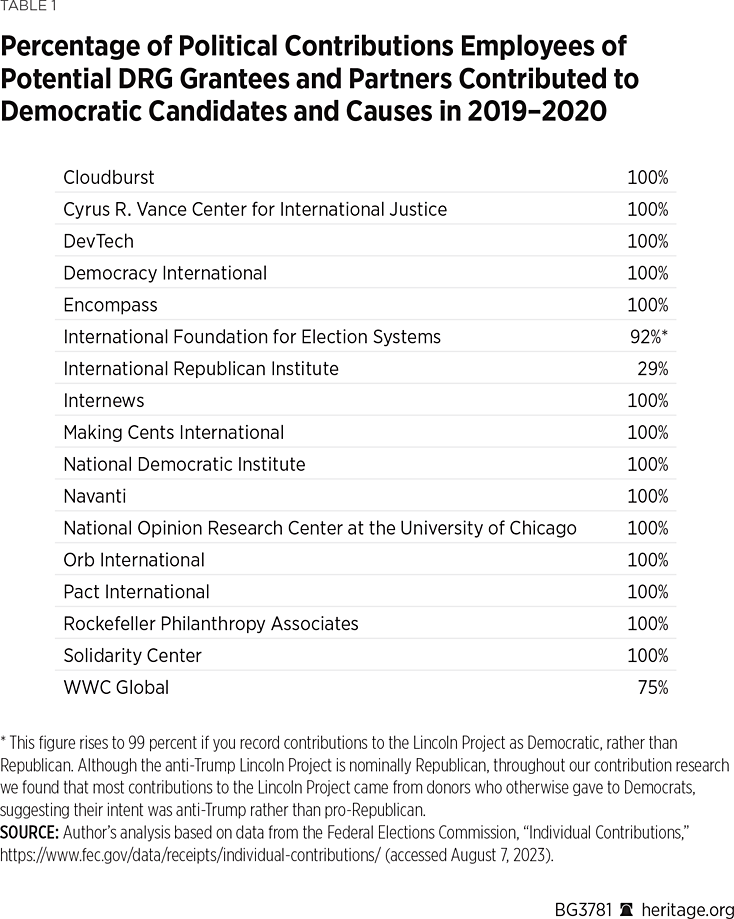
InterAction
Founded in 1984, InterAction is the largest coalition of international NGOs in the United States. According to its website, InterAction is a nonpartisan convener, thought leader, and voice for NGOs that mobilizes its members to think and act collectively to serve the world’s poor and vulnerable. In practice, InterAction functions as a highly partisan advocate of the highly partisan foreign aid industrial complex. It exercises significant influence over congressional decisions on foreign aid appropriations by characterizing itself as a fair and nonpartisan voice concerning foreign aid. During the 2019–2020 campaign period, 29 InterAction employees made 366 individual contributions totaling $18,470.53, with all of its employee contributions going to Democrats.
Why Political Representation Matters in Foreign Assistance
In a very real sense, foreign assistance spending is discretionary and wholly dependent (through their representatives in Congress) on the charity and goodwill of the American people. Public support for foreign assistance remains strong: A survey on public attitudes toward foreign assistance in 2022 found that two-thirds of Americans support foreign aid as a means to ensure global stability, and a slight majority (53 percent) support maintaining or increasing the current foreign aid budget.REF As overall public trust in government continues to decrease,REF the realization that the U.S. foreign assistance apparatus is not bipartisan creates the increasing possibility that public support for assistance will also decline.
The blatant politicization of foreign assistance by the Biden Administration also creates the risk that Congress, or a future non-Democrat Administration, will cut all funding to mono-partisan patronage organizations perceived as prioritizing an ideological agenda instead of addressing global poverty and instability. It is unlikely that the taxpaying public will want to fund foreign aid if it seen as a patronage-based employment program for Democrat Party activists promoting a partisan political and social agenda at home and abroad.
The politicization of foreign assistance also damages U.S. foreign policy. Rather than offering a helping hand, U.S. assistance is increasingly tied to social and political “reforms” that aid beneficiaries view as neocolonial and oppressive. This policy risks driving nations into the arms of China and Russia, which impose no such conditions on their bilateral relationships.
Recommendations
Congress funds the foreign aid budget and has primary responsibility for protecting taxpayer funds from partisan misuse. As such, Congress should take the following actions:
- Order a Government Accountability Office investigation of potential civil rights violations in hiring practices at the U.S. State Department and USAID. Congress should consider a hold on a substantial part of their foreign aid funding and institute a hiring freeze until the investigation is complete. In addition, Congress should include in a future foreign aid bill a requirement that both institutions develop plans to eliminate systemic and institutionalized politically partisan bias in federally funded hiring.
- Demand that the State Department, USAID, the National Endowment for Democracy and its core institutes, and their main implementing partners explain the lack of political diversity in their organizations and how they plan to rectify their gross political bias.
- Consider suspending further foreign aid funding to any organization—government and nongovernment—that creates a politically hostile working environment as measured by political contributions.
Conclusion
The Biden Administration has asked Congress to approve its $70 billion-plus foreign assistance budget for FY 2024, which is both the largest ever foreign aid budget request and the largest year-on-year increase. Before American taxpayers are asked to foot this bill, they should be confident that their funds will not be misused to finance a Washington-based patronage system that benefits the most radical elements of American society that seeks to replicate itself globally.
Tim Meisburger is a Visiting Fellow in the Douglas and Sarah Allison Center for Foreign Policy Studies at The Heritage Foundation.


